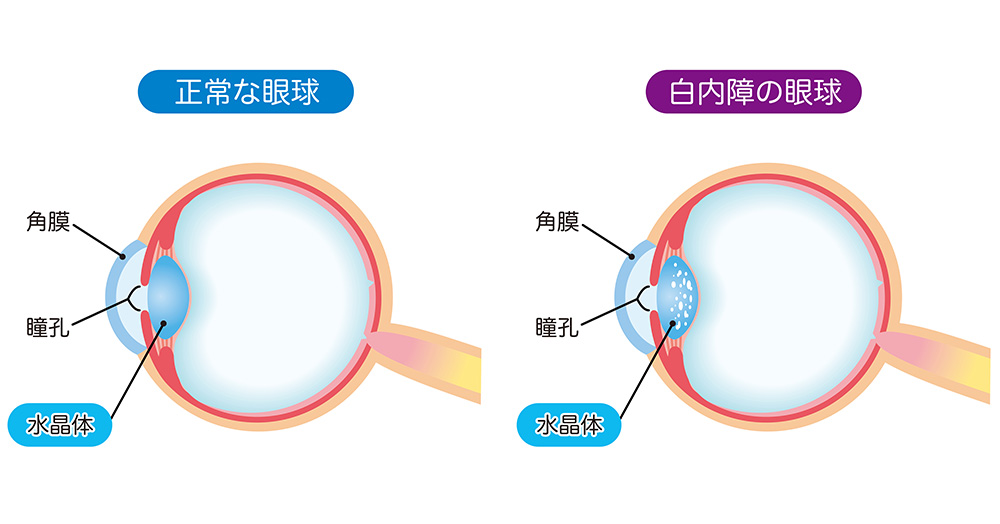What is Cataract?
Cataract is a disease in which the lens (the lens part of the eye) becomes cloudy.
This disease is common in people over the age of 40 and can affect vision.
When the lens becomes cloudy, objects may appear blurred, double vision, or dazzling.
As the disease progresses, vision deteriorates.
The main cause of cataracts is aging. This is called “senile cataract.
It can begin as early as the 40s, and many people in their 80s may have cataracts.
Other causes include injury or other eye diseases, and some are congenital.
Cataract Treatment
If the cataract has not yet progressed, it may be possible to slow its progression with medication, but it cannot be completely cured.
In advanced cases, the cloudy lens is surgically removed and an artificial lens (intraocular lens) is inserted in its place.
The surgery is performed under anesthesia and is painless. The patient can hear the doctor and talk during the surgery.
Surgery time varies depending on the symptoms, but usually takes about 30 minutes.
Currently, the most common surgical method is the “ultrasonic phacoemulsification and aspiration method.
In this method, the cloudy lens is sucked out through a small wound of approximately 3 mm using ultrasound, and an intraocular lens is inserted into the thin membrane that remains.
The intraocular lens is an artificially created lens and is necessary to restore vision.
If this is not inserted, the patient will become farsighted after the surgery and their vision will not match.
There are many different types of intraocular lenses.
Some absorb ultraviolet rays, some are slightly colored like sunglasses, and some are “multifocal” lenses that allow both distance and near vision.
Most people use “monofocal” lenses, and most of our patients also use “monofocal” lenses.
Preoperative Preparation
If you decide to undergo surgery, you will be asked to undergo a detailed examination of the condition of your eyes prior to surgery.
If there is a hidden disease in the fundus or optic nerve, vision may not be restored even if the surgery is successful.
In addition, the refractive power of the artificial lens must be determined prior to surgery.
If this is not appropriate, you may develop strong myopia or hyperopia after the surgery.
Accurate measurement can be difficult, especially for those who already have strong myopia or hyperopia.
Post-operative Precautions
Our cataract surgery is performed as a day surgery. Normal life can be resumed immediately after surgery, although a little rest is required.
Accurate measurement can be difficult, espe
However, you should use the prescribed eye drops for 2 to 3 months after the surgery and be careful not to rub your eyes.
Consult with your doctor regarding the use of eye pads and sunglasses.
Also, refrain from strenuous exercise until your doctor gives you permission, and consult with your doctor about driving or any special tasks that require the use of your eyes.
Day Surgery Flow
Cataract surgery is a procedure in which the lens (lens) of the eye is removed and an artificial lens (intraocular lens) is inserted when the lens becomes cloudy and vision is impaired.
Day surgery for cataract is a type of surgery that allows the patient to go home on the same day without hospitalization.
The surgery itself is relatively simple and can be completed in a short time, so there is no need to be hospitalized.
The following is a guide to the day surgery process at our clinic.
Preparation (preoperative medical examination)
-
Examination and Testing
Before surgery, there is an examination to check the condition and health of the eye. These include visual acuity tests, intraocular pressure tests, fundus examinations, and tests to evaluate the progression of cataracts.
-
Intraocular lens selection
The best intraocular lens for the patient's eye is selected. The appropriate lens is selected based on the presence or absence of myopia, hyperopia, or astigmatism.
-
Determination of surgery schedule
Based on the results of the consultation, a surgery schedule will be set and the necessary preparations prior to surgery will be explained.
Day of Surgery
-
Anesthesia eye drops
Local anesthetic drops are placed in the eye to be operated on. This will numb the sensation around the eye without causing pain during the surgery.
-
Disinfection and Cover
Disinfect the area around the eyes and face and cover the face with a clean cover. This prevents infection during surgery.
-
Small incision
The surgery is performed through a very small incision, usually about 2 to 3 millimeters, in the cornea (surface of the eye). Through this incision, surgical instruments are inserted.
-
Removal of lens
The cloudy lens is broken into small pieces by ultrasound, aspirated, and removed. This method is called the “ultrasonic phacoemulsification and aspiration method.
-
Intraocular lens insertion
After the lens is removed, an artificial intraocular lens is inserted into the eye. This restores vision. The lens is very thin, transparent, and fits snugly inside the eye.
Postoperative Recovery
-
Time to rest your eyes
After surgery, rest and relax your eyes for a few hours. You will often feel your vision begin to recover, but it may take a little longer to fully recover.
-
Eye drops
After surgery, you will be prescribed antibiotic and anti-inflammatory eye drops. These are used for several days to prevent infection and inflammation.
-
Explanation of precautions
After surgery, the ophthalmologist or nurse will explain postoperative care and precautions. These precautions include not rubbing the eye too hard, not exerting excessive force, and avoiding heat therapy.
Returning home and postoperative stay
-
Returning home
After the surgery, if there are no abnormalities, the patient may go home that day. Immediately after surgery, you will be instructed to avoid driving and strenuous exercise.
-
Restrictions on showering and face washing
Showering and face washing may be limited for a while after the surgery. Usually, light washing of the face is allowed one to two days after the surgery.
Postoperative follow-up
-
Observation
You will need to come back to our office for a follow-up examination in a few days. Thereafter, regular checkups will continue to monitor your vision and eye condition.
Important point
-
After surgery, avoid rubbing the eyes or exposure to strong light for some time. Wearing an eye mask may be recommended to protect the eyes.
-
Improvement of vision can take time. It may take several weeks of adjustment before the eyes open clearly.
-
Use eye drops as directed to prevent eye irritation and infection.
-
After surgery, vision is often restored within a few days and the patient can see better than before surgery. However, it may take several weeks to fully stabilize. The degree of improvement in vision and the speed of recovery vary from person to person.
Our system of cataract day surgery

Ophthalmologist
Satoru Yamagami MD, PhD
Chief Professor, Department of Ophthalmology, Nihon University School of Medicine
SpecializationCorneal and Conjunctival Diseases
About consulting our clinic
Cataracts are common among the elderly, and treatment methods have advanced in recent years.
Surgery has become safer and, thanks to intraocular lenses, vision can be restored.
Many patients have recovered good vision after surgery and are able to return to their daily lives.
We offer day surgery for cataract.
Please feel free to consult with us to resolve any concerns or questions you may have regarding cataract treatment, and we will proceed with a treatment that is suited to your needs.




Medical Specialists and Certified Medical Doctors